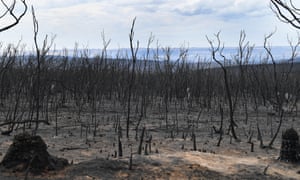Habitat untouched by the fires, which were five times as large as
those in the Amazon last year, is critical for their survival, report
finds
Nearly 50 Australian native species not currently listed as threatened could be at risk as a result of the continent’s devastating bushfire season, according to a study drawing on the work of more than 20 leading scientists.
The researchers identified 70 animals that had much of their habitat affected by bushfire, including 49 that were not currently protected under national environment laws but should be urgently assessed.
If all were found to be at risk it would increase the number of Australian land and freshwater animals recognised as threatened by 14%.
The publication of the peer-reviewed study in the journal Nature Ecology and Evolution followed the Morrison government on Monday releasing an independent review of the laws, known as the Environment Protection and Conservation Biodiversity (EPBC) Act.The researchers identified 70 animals that had much of their habitat affected by bushfire, including 49 that were not currently protected under national environment laws but should be urgently assessed.
If all were found to be at risk it would increase the number of Australian land and freshwater animals recognised as threatened by 14%.
The interim review led by Graeme Samuel, a former competition watchdog head, found Australia’s environment was in an unsustainable state of decline and the laws were not fit to address current and future environmental challenges.
Samuel recommended the introduction of national environmental standards that set clear rules for conservation protection while allowing sustainable development, and the establishment of an independent environmental regulator to monitor and enforce compliance.
The environment minister, Sussan Ley, agreed to develop environmental standards, but rejected the call for an independent regulator and said she would immediately start work on an accreditation process to devolve responsibility for most environmental approvals to the states and territories.
One of the Nature Ecology study’s authors, Prof James Watson, said the laws could be effective but only if protections were enforced. The act, which has been widely criticised for failing to stem a developing extinction crisis, largely leaves decisions to the discretion of the environment minister of the day.
The researchers found three species – the Kangaroo Island dunnart, the long-footed potoroo and Kate’s leaf-tailed gecko – had more than 80% of their habitat affected by fire. Unprotected animals that required assessment included the gecko and the short-eared possum.
Watson, from the University of Queensland’s school of earth and environmental sciences, said the country needed to protect the “large, intact places” that have not burned or been logged or cleared for development.
“They are critical for the survival of these species,” he said. “If we don’t, we’ll run out of time and lose these species in the next fire, or the one after that.”
The cross-institutional study was coordinated by Michelle Ward, a University of Queensland doctoral student. It found the fires between July 2019 and February 2020 were unprecedented in their spatial extent and severity. They were at least 50 times more extensive than California’s worst recorded wildfires and five times as large as those in the Amazon last year.
About 97,000 sq km of vegetation burned in areas across southern and eastern Australia that were home to at least 832 native animal species. The study was limited and did not consider the impact on plants, invertebrates and non-threatened freshwater fish and turtles.
Ward said many of the species affected had already been in decline due to drought, disease, habitat destruction and the impact of invasive species.
“Our research shows these megafires may have made the situation much worse by reducing population sizes, reducing food sources and rendering habitat unsuitable for many years,” she said.
“We must assist the recovery of populations in both burnt and unburnt areas. This means strictly protecting important habitats, like unburnt refuges.”
Watson said the study was the most comprehensive examination to date of the impact of the fires on species, pulling together data from across the country.
He said it was in humans’ best interest to look after and live with nature. Beyond its intrinsic value, it helped create rain, prevent drought, store carbon dioxide and restore mental health.
“I’m confident with real leadership we can see a change and live with wildlife, but we need someone to step up and say humans can’t have everything,” he said. “We need nature as well.”
Investigations by Guardian Australia have found widespread problems with the laws, including poor monitoring of endangered species, major delays in the listing of threatened species and ecosystems, failure to develop and implement recovery plans, failure to protect important habitat and threatened species funding being used for projects that do not benefit threatened species.

No comments:
Post a Comment